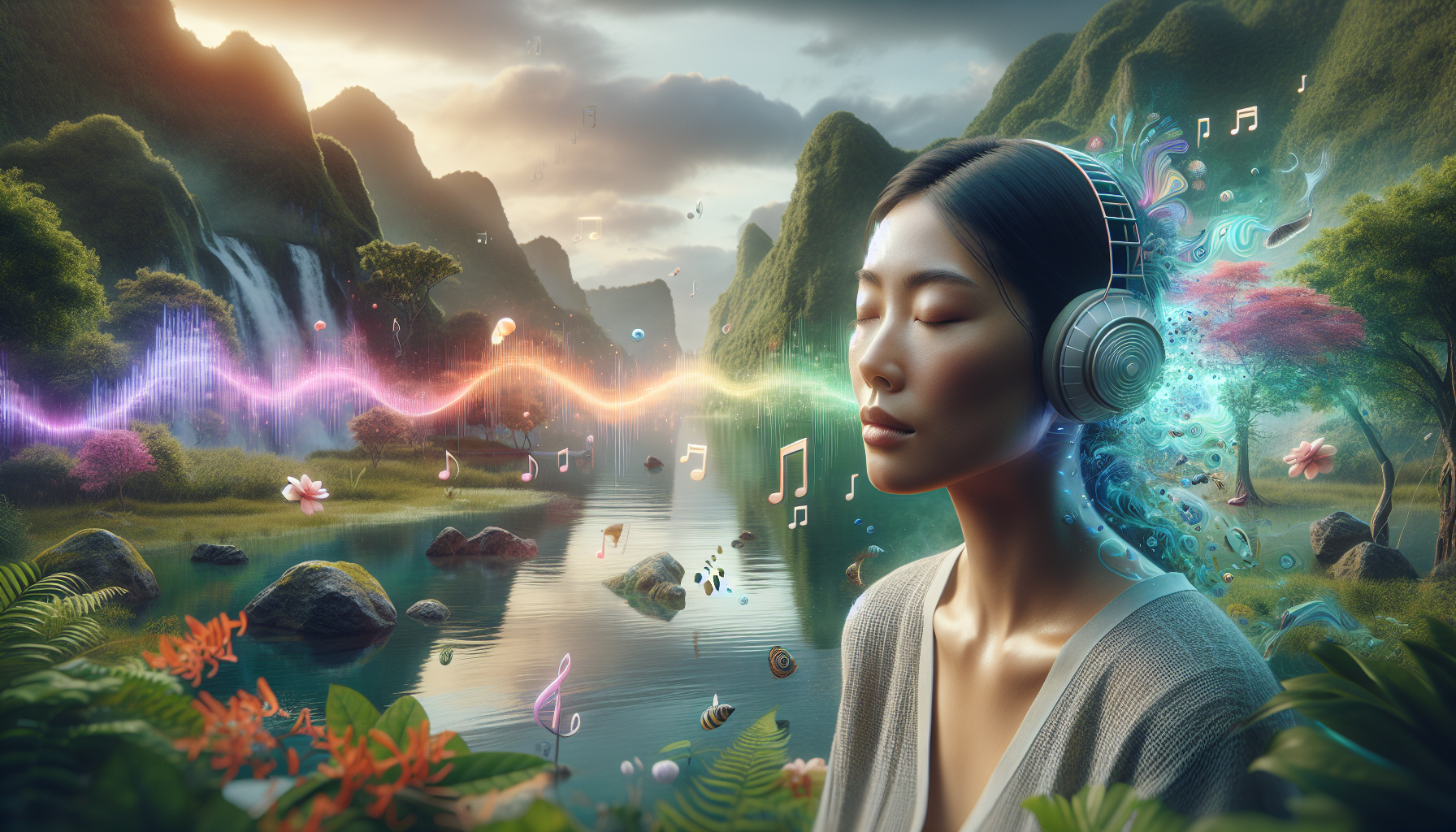In a world where the hustle and bustle often drown out the subtleties of life, the art of truly listening becomes both a refuge and a revelation. Imagine being able to capture the essence of a moment not just with a photograph or a journal entry, but with the ambient sounds that colored that experience. Welcome to the intriguing realm of Ambient Sound Memoirs—a technique that allows you to etch memories into your consciousness by harnessing the power of sound. 🎧 This journey will not only transform the way you perceive your surroundings but will also offer you a unique method to revisit your past with a depth and richness that words alone may fail to convey.
As we embark on this exploration, we will delve into the core of what makes ambient sound an extraordinary tool for memoirists and memory keepers. From the gentle rustle of leaves on a breezy autumn day to the distant murmur of a bustling cityscape, ambient sounds have the remarkable ability to evoke emotions and transport us back in time. Our sensory memory is powerful, and when we learn to engage it fully, we can create a more immersive and evocative personal history. Through this article, you will gain insights into the fundamental techniques of capturing and curating ambient sounds that reflect the tapestry of your experiences.
In the following sections, we will uncover the practical steps to mastering ambient sound memoir techniques, starting with the equipment and technology that will best serve your purpose. Whether you’re a tech enthusiast or a minimalist, there are tools tailored to every preference and budget. We’ll discuss the art of attentive listening—how to tune in to the subtleties of soundscapes and identify those which resonate most deeply with your narrative. Moreover, we’ll explore the creative process of layering sounds to craft a dynamic and authentic auditory story. By honing these skills, you will not only enhance your personal archives but also elevate the storytelling experience for any audience you choose to share it with.
Finally, we will address the personal and emotional impact of immersing yourself in sound. Collecting and curating ambient sound is not merely an artistic endeavor; it is a deeply introspective journey that can foster mindfulness and connection to the present moment. As you learn to attune your ear to the world around you, you may find yourself developing a heightened appreciation for the nuances of your environment and a deeper understanding of your own narrative. Whether you are an aspiring memoirist, a seasoned storyteller, or someone simply seeking a new way to engage with your memories, this guide will equip you with the knowledge and inspiration to create truly memorable auditory experiences. So, let us dive into the harmonious world of ambient sound, where every whisper and echo tells a story waiting to be heard. 🎶
Understanding Ambient Sound Memoir Techniques
Ambient sound memoir techniques offer a unique and immersive way to capture and convey experiences, turning ordinary memories into extraordinary narratives. These techniques rely on the strategic use of ambient sounds to evoke emotions, transport listeners to a specific time and place, and enhance the overall storytelling experience. Whether you’re an aspiring podcaster, a seasoned storyteller, or someone looking to preserve personal memories, mastering ambient sound memoir techniques can significantly elevate your work.
The essence of ambient sound memoir techniques lies in their ability to create an immersive soundscape that envelops the listener. By incorporating environmental sounds, such as the gentle rustling of leaves, the distant hum of traffic, or the rhythmic crashing of ocean waves, storytellers can provide a multisensory experience that goes beyond mere narration. This technique taps into the listener’s imagination, allowing them to visualize and feel the story in a more profound way.
Moreover, these techniques are not just about adding sounds to a narrative. They require careful selection and placement of sounds to ensure they complement the story and do not distract from it. This involves understanding the story’s emotional arc and identifying key moments where sound can enhance the narrative impact. The result is a more engaging and memorable experience for the audience.
The Power of Sound in Storytelling
Sound plays a crucial role in storytelling, often serving as the unsung hero that adds depth and emotion to narratives. From the iconic scores of blockbuster movies to the subtle soundscapes of radio dramas, sound has the power to transform stories. In the realm of ambient sound memoirs, sound is used to anchor memories, making them more vivid and relatable.
Consider the difference between reading a story about a bustling city street and listening to one where you can hear the chatter of passersby, the distant honking of car horns, and the rhythmic footsteps on the pavement. The latter not only paints a more vivid picture but also evokes emotions and memories that are unique to the listener. This is the magic of ambient sound in storytelling.
For creators, this means learning to listen actively to their surroundings and identifying sounds that can enhance their narratives. It involves experimenting with different recording techniques, such as binaural recording, which captures sound in a way that mimics human hearing. This creates a three-dimensional sound experience that is both realistic and immersive.
Techniques for Capturing Ambient Sound
Capturing ambient sound is both an art and a science. It requires a keen ear, the right equipment, and an understanding of the environment. Here are some techniques to help you master the art of capturing ambient sound for your memoirs:
- Choosing the Right Equipment: Investing in quality microphones and recording devices is essential. Look for equipment that captures sound accurately and can handle a range of frequencies. Portable recorders are ideal for capturing spontaneous sounds, while shotgun microphones are great for isolating specific sounds in noisy environments.
- Understanding the Environment: Before recording, spend time listening to the environment. Identify the dominant sounds and how they interact with each other. This will help you decide what sounds to capture and how to position your microphone for optimal recording.
- Experimenting with Techniques: Try different recording techniques to achieve the desired effect. For instance, using a stereo microphone can create a sense of space and dimension, while a mono microphone can focus on specific sounds. Additionally, consider the use of windshields and shock mounts to minimize unwanted noise.
To see these techniques in action, check out this video on “Capturing the Perfect Soundscape” by Sound Guru Channel. It offers a practical demonstration of various recording methods and provides tips on how to enhance your ambient sound recordings.
Integrating Ambient Sounds into Your Memoir
Once you’ve captured ambient sounds, the next step is integrating them into your memoir. This process involves careful selection, editing, and layering of sounds to create a cohesive and engaging narrative. Here are some tips to guide you through this process:
Selecting the Right Sounds: Not all captured sounds will fit your narrative. Listen to your recordings and select sounds that enhance the story and evoke the desired emotions. Consider how each sound contributes to the overall mood and setting of your memoir.
Editing and Layering: Use audio editing software to trim, enhance, and layer sounds. Pay attention to the timing and volume of each sound to ensure they blend seamlessly with your narration. Experiment with effects like reverb and equalization to create a balanced soundscape.
Testing and Iterating: Share your work with a small audience and gather feedback. Listen to your memoir through different audio devices to ensure it sounds good across various platforms. Make adjustments based on feedback and continue to refine your soundscape.
The Emotional Impact of Ambient Sound Memoirs
Ambient sound memoirs have a unique ability to evoke strong emotional responses from listeners. By carefully selecting and integrating sounds that resonate with the story’s themes and emotions, creators can forge a deep connection with their audience. This emotional engagement is what makes ambient sound memoirs stand out in the realm of storytelling.
For example, the sound of rain tapping against a window can evoke feelings of nostalgia or melancholy, while the laughter of children playing in a park can bring joy and warmth. These sounds can trigger memories and emotions that are personal to each listener, making the story more relatable and impactful.
To illustrate the power of sound in evoking emotions, consider this table that compares different sounds and their typical emotional associations:
| Sound | Emotional Association |
|---|---|
| Gentle Rain | Nostalgia, Calm |
| Ocean Waves | Serenity, Freedom |
| Birdsong | Joy, Renewal |
| City Traffic | Excitement, Chaos |
These associations are not fixed, as they can vary based on individual experiences and cultural contexts. However, they provide a starting point for creators to consider how different sounds might enhance their narratives. By understanding the emotional impact of sounds, storytellers can craft more nuanced and resonant memoirs.
Enhancing Listener Engagement Through Sound
Ambient sound memoirs have the potential to captivate listeners by immersing them in a rich auditory experience. By skillfully weaving together narration and ambient sounds, creators can hold their audience’s attention and encourage them to listen more actively. This heightened engagement can lead to a deeper appreciation of the story and its themes.
One effective way to enhance listener engagement is to create contrast and variation in the soundscape. By alternating between quiet, intimate moments and dynamic, bustling scenes, creators can maintain interest and prevent monotony. This technique mirrors the natural ebb and flow of life, making the memoir feel more authentic and relatable.
Additionally, consider incorporating interactive elements into your memoir. Encourage listeners to reflect on their own experiences or imagine themselves in the story’s setting. Posing questions or inviting listeners to share their thoughts can foster a sense of connection and involvement, enriching the overall experience.

Conclusion
Creating a truly memorable experience through the art of sound requires not just technical skill, but also a deep appreciation for the nuances of ambient sound memoir techniques. Throughout our exploration of “Immerse Yourself: Mastering Ambient Sound Memoir Techniques for a Truly Memorable Experience,” we delved into the intricate world of soundscapes and their profound impact on storytelling and memory retention.
At the heart of this topic is the understanding that sound is not merely an auditory experience; it’s an emotional journey that can transport, transform, and transcend the listener’s immediate environment. We began by highlighting the significance of ambient sounds, which are often overlooked yet incredibly powerful in evoking memories and emotions. Ambient sound serves as a backdrop that enriches the narrative, providing context and depth to any story or experience. The way these sounds are captured, layered, and integrated into a memoir can significantly enhance the listener’s connection to the narrative.
One of the key points we discussed is the technique of active listening. This involves tuning into the subtle layers of sound in our environment, from the gentle rustling of leaves to the distant hum of traffic. Active listening sharpens our awareness and sensitivity, enabling us to recreate authentic soundscapes that resonate on a personal level. By immersing ourselves in this practice, we can effectively curate soundscapes that not only complement our stories but also amplify their emotional impact.
We also explored the technical aspects of sound recording and editing, essential skills for mastering ambient sound memoir techniques. The choice of equipment, such as high-quality microphones and sound editing software, plays a crucial role in capturing the richness of ambient sounds. Techniques like binaural recording, which mimics the way human ears perceive sound, can create a 3D audio experience that places the listener at the heart of the narrative. By embracing these technological advancements, storytellers can push the boundaries of traditional memoirs, crafting experiences that are immersive and unforgettable.
Moreover, we delved into the art of layering sounds to build complex auditory environments. Just as a painter layers colors to create depth in a painting, a sound artist layers audio elements to produce a rich tapestry of sound. This process involves careful selection and blending of sounds to evoke specific emotions or highlight particular moments within the story. The strategic use of silence, too, plays a pivotal role, providing contrast and allowing moments of reflection for the listener.
The emotional resonance of sound was another focal point in our discussion. Sound has the unique ability to trigger powerful emotional responses, often bypassing rational thought to tap directly into our feelings. By understanding the psychological impact of different sounds, we can intentionally design soundscapes that evoke desired emotional reactions. Whether it’s the soothing sound of ocean waves or the nostalgic melody of a distant piano, the right sound at the right moment can elevate a memoir from memorable to transformative.
In recognizing the power of sound, we cannot overlook its potential for accessibility and inclusivity. Ambient sound memoir techniques offer a unique avenue for individuals with visual impairments to experience stories in a rich and immersive way. Sound becomes the primary medium through which stories are not just told, but felt. This inclusivity enriches the storytelling landscape, making it more diverse and accessible to a broader audience.
As we conclude this exploration, it’s essential to reinforce the importance of embracing ambient sound memoir techniques as a valuable tool for storytellers, artists, and anyone interested in creating meaningful experiences. The ability to craft a narrative that resonates deeply with an audience is a skill that transcends traditional storytelling, offering new dimensions of creativity and engagement.
We encourage you, the reader, to take the insights gained from this discussion and apply them to your own storytelling endeavors. Experiment with sound, embrace the nuances of ambient soundscapes, and allow yourself to be immersed in the world of auditory storytelling. Whether you’re crafting a personal memoir, developing a podcast, or simply exploring the world of sound, these techniques can elevate your work to new heights.
Furthermore, we invite you to share your experiences and insights with others. By discussing and exchanging ideas, we can collectively enhance our understanding and appreciation of the power of sound. Comment below with your thoughts, share this article with fellow storytellers, or collaborate on projects that push the boundaries of traditional narratives.
In closing, remember that the world of sound is vast and full of potential. By mastering ambient sound memoir techniques, you open the door to a universe of storytelling possibilities. So, immerse yourself in sound, let your creativity flow, and craft experiences that are not only heard but truly felt. 🎧✨
For further reading and resources on mastering ambient sound memoir techniques, consider exploring Sound On Sound, Transom, and The Sonic Society. These platforms offer a wealth of knowledge and inspiration for anyone passionate about the art of sound.
By embracing the art and science of sound, you embark on a journey of discovery and creativity that knows no bounds. Let the soundscapes you create be the vessels through which stories come alive, leaving a lasting imprint on the hearts and minds of your audience.
Toni Santos is a sensory storyteller and soundscape artisan whose work explores the forgotten language of the Earth through acoustic ecology storytelling. With a deep reverence for the natural world’s sonic textures, Toni crafts narratives that awaken our ears to the subtle music of forests, winds, waters, and wild silence.
His creative journey is rooted in a desire to preserve and interpret the acoustic heritage of environments, both ancient and fragile. From the echo of birdsong in a disappearing jungle to the resonance of stones in sacred landscapes, Toni’s stories reflect the memory held in sound—often overlooked, yet deeply felt.
With a background in environmental aesthetics and sonic design, Toni blends field recordings, visual symbolism, and poetic insight to create immersive experiences that honor the sonic soul of nature. His work does more than document; it invites listeners to re-tune themselves to the rhythms of life that still pulse beneath modern noise.
As the voice behind Vizovex, Toni shares sound-based studies, ambient narratives, and reflective content that help others reconnect with how sound shapes memory, meaning, and place.
His work is a tribute to:
The lost soundscapes of vanishing ecosystems
The role of natural acoustics in cultural and emotional memory
The healing potential of listening deeply to the world
Whether you’re an artist, an ecologist, or someone drawn to the quiet power of listening, Toni invites you into a space where every rustle, ripple, and resonance becomes a story—one note, one place, one heartbeat at a time.




